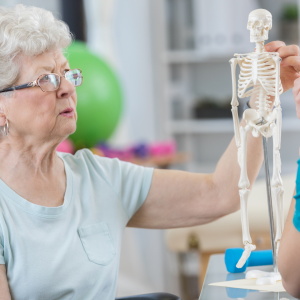A recent article in the Exercise and Sports Sciences Reviews Journal detailed the key elements to a successful exercise program in the management of osteoporosis. The following article covers some of the key points that were discussed. Of course many of the points are what is ideal based on research and need to be altered according to risk and individual ability.
First and foremost the safety of exercise cannot be overstated. While medications are an important part of management for people with low bone density, they almost always come with unwanted side effects and their effects are not universal across all people. When prescribed by a health professional such as an exercise physiologist, there are virtually no side effects associated with exercise. Further to this, the recipient of the exercise intervention always has some positive health response associated with their participation even if that is not directly linked to changes in bone density. There are very few interventions where this is the case.
The second area discussed in depth were the loading parameters which are required to maximise the benefit derived from the exercise program. Loading must be cyclic or dynamic in nature rather than static. For example, a squat hold is less effective at targeting bone density when compared to repeated squats. In addition to being dynamic, the load must be greater than the everyday loads that the bones are usually exposed to. This is one of the reasons why walking has limited effects on bone density when compared to targeted exercises. It is also the reason why regular program changes are important to ensure that continual improvement occurs. The frequency of loading (in hertz) that is required to stimulate bone growth is between 15-50Hz. Walking typically produces loads between 1-2Hz. The discovery of this ideal frequency of loading led to the introduction of whole body vibration as a suggested method for increasing bone density. However despite this, most human studies show that whole body vibration is not superior to an individualised program of targeted resistance exercises.
In addition to loading frequency, the number of loading cycles is also important. This is commonly referred to as the number of repetitions performed. Research indicates that a minimum of 4 cycles is required to maintain bone mass, with load cycles of up to 36 (or for example 3 sets of 12) leading to bone density increases of up to 42%. There appears to be no added benefit to bone density from increasing the number of repetitions beyond 36. A better way to produce further increases is through added external load rather than continuing to increase the repetitions.
The speed of loading is also an important factor, with faster loading rates leading to greater bone density improvements. Power or speed based exercises also featured in another recent review that showed a slight advantage of adding power based exercises to overall health and well-being when compared to traditional strengthening exercises alone. The main consideration with this type of loading is safety, as most of the research that has looked into loading rate has been performed on people with healthy bone density levels. This type of loading is best suited to people with some years of experience performing strengthening exercises. It is also not suited to those individuals with a high overall fracture risk – indicated by a history of minimal trauma fractures and extremely low T score values (eg -3 or below).
Finally, it is important to note that while changes to the bone mineral density value don’t always occur, that there are still structural changes to the organisation of bone that improve it’s strength and therefore reduce fracture risk. These changes are not picked up in DEXA scans, however different imaging performed during research trials has shown increases in the thickness of the outer part of the bone. The largest bone density changes are also commonly seen in the people with the lowest baseline values rather than those who are only marginally below the normal reference ranges. So even if your DEXA result is not changing, know that there is very high probability that you are making positive changes.
To summarise:
- The most effective exercises involve cyclic or dynamic movements rather than position holds
- The ideal number of sets and repetitions performed are in the 3 x 8 to 3 x 12 range. If an exercise becomes easy and you are performing 3 x 12 repetitions, it is best to change the exercise or add extra load
- If you have 1+ years experience with strengthening exercises and have a low fracture risk (no minimal trauma fractures and T score above -3) the addition of power or fast paced strengthening exercises can have significant impacts on bone density
- An individualised and targeted resistance exercise program prescribed by a qualified health professional is the gold standard in exercise management
- Regular program changes are essential to ensure that the body is continually challenged as it is good at adapting to regular activities
- DEXA scan results do not measure the thickening of outer bone that is shown to occur with exercise interventions an hence may not give a complete picture of the effects of exercise on your bone health
As always, it is important to make sure that you seek the assistance of a qualified health professional such as an exercise physiologists to ensure that you are given an exercise program that is unique to your needs, and that balances out benefit with safety.

